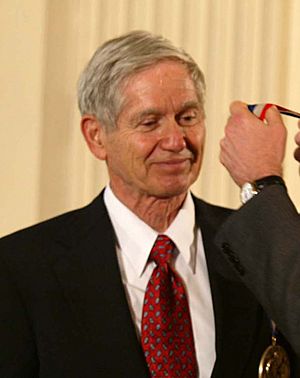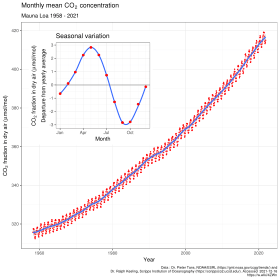Charles David Keeling facts for kids
Quick facts for kids
Charles David Keeling
|
|
|---|---|

Keeling receives the Medal of Science in 2001
|
|
| Born | April 20, 1928 |
| Died | June 20, 2005 (aged 77) |
| Citizenship | American |
| Alma mater | University of Illinois Northwestern University |
| Known for | Keeling Curve |
| Awards | Second Half Century Award, American Meteorological Society (1981) Maurice Ewing Medal (1991) Blue Planet Prize (1993) National Medal of Science (2002) Tyler Prize for Environmental Achievement (2005) |
| Scientific career | |
| Fields | Atmosphere |
| Institutions | Scripps Institution of Oceanography |
| Doctoral advisor | Malcolm Dole |
Charles David Keeling (born April 20, 1928 – died June 20, 2005) was an American scientist. He is famous for his work on carbon dioxide (CO2) in Earth's atmosphere. Keeling measured CO2 levels at the Mauna Loa Observatory in Hawaii.
His measurements showed that CO2 levels were steadily rising. This helped confirm that human activities were adding to the "greenhouse effect" and global warming. The data he collected is known as the Keeling Curve. It shows how carbon dioxide, a gas that traps heat, has built up in our atmosphere.
Contents
Early Life and Studies
Keeling was born in Scranton, Pennsylvania. His father was an investment banker who sparked Charles's interest in astronomy when he was five. His mother taught him to love music, which lasted his whole life.
He studied chemistry at the University of Illinois at Urbana-Champaign. He graduated in 1948. Charles Keeling then earned his PhD in chemistry from Northwestern University in 1953. He worked with a professor named Malcolm Dole.
Many students from his program went to work in the oil industry. But Keeling was more interested in geology. He applied for jobs in geology departments, mostly in the western United States. He got an offer from Harrison Brown at the California Institute of Technology (Caltech). He worked there as a researcher until 1956. Then he joined the Scripps Institution of Oceanography. In 1968, he became a professor of oceanography there.
At Caltech, Keeling created a new tool. This tool could measure carbon dioxide in air samples very accurately. He used this device while camping at Big Sur. He found that CO2 levels had gone up since the 1800s.
Studying the Atmosphere at Scripps
Keeling worked at the Scripps Institution for 43 years. During this time, he wrote many important scientific papers. Roger Revelle, who was the director of Scripps, convinced Keeling to continue his research there.
Revelle also helped start the International Geophysical Year (IGY) in 1957–58. Keeling received money from IGY to set up a research station. This station was on Mauna Loa in Hawaii, about 3,000 meters (two miles) above sea level.
Keeling began collecting carbon dioxide samples there in 1958. By 1960, he noticed something interesting. CO2 levels changed with the seasons. They were highest in the late winter in the Northern Hemisphere. Then, they dropped in spring and early summer. This happened as plants grew more in the Northern Hemisphere.
In 1961, Keeling showed data that CO2 levels were rising steadily. This steady increase became known as the "Keeling Curve".
In the early 1960s, the National Science Foundation stopped funding his research. They said the work was "routine." But even without their support, his research was used. In 1963, the Foundation warned about increasing heat-trapping gases. A 1965 report from President Lyndon B. Johnson's science advisors also warned about these gases. They explained how these gases could make Earth's temperature rise.
The data collection started by Keeling at Mauna Loa is still going on today. It is the longest continuous record of atmospheric carbon dioxide in the world. Scientists trust it as a key indicator of global CO2 trends. Keeling's research showed that CO2 grew from 315 parts per million (ppm) in 1958 to 380 ppm in 2005. These increases matched the amount of fossil fuels being burned.
Personal Life and Hobbies
Keeling loved the outdoors. He often went hiking and camping in the Western mountains. He especially enjoyed the Cascade Range in Washington state. He was an active member of the Wilderness Society.
He married Louise Barthold in 1954. They had five children. One of his sons, Ralph Keeling, also became a climate scientist at Scripps Institution of Oceanography.
Charles Keeling was also a talented classical pianist. He almost chose music as his career. He helped start the Madrigal Singers at the University of California, San Diego. He also led a committee that created the "Community Plan" for Del Mar, California, in 1975.
Keeling passed away in 2005 at age 77. He died from a heart attack.
Keeling's Important Legacy
- In July 1997, Keeling received a special award from Vice President Al Gore. He was honored for 40 years of amazing research. This research involved monitoring carbon dioxide at the Mauna Loa Observatory.
- The Keeling Curve is very famous. It is "engraved in bronze" on a building at Mauna Loa. It is also carved into a wall at the National Academy of Sciences in Washington.
- In the 1960s, Al Gore was a student at Harvard University. He saw the Keeling Curve chart in a classroom. He said he "marveled" at it. In 2006, Gore showed the graph in his book and movie An Inconvenient Truth. He later won the Nobel Peace Prize with the United Nations' Intergovernmental Panel on Climate Change.
- The Charles David Keeling apartments opened in 2011. They are at Revelle College of the University of California, San Diego. These buildings were designed to be environmentally friendly.
- A play called Dr Keeling's Curve was written in 2014 by George Shea. It was performed by Mike Farrell.
Awards and Fellowships
Keeling received many honors during his career:
- He was a Guggenheim fellow at the Meteorological Institute, Stockholm University (1961–62).
- He was a guest professor at the Second Physical Institute of the University of Heidelberg (1969–70).
- He was also a guest professor at the Physical Institute of the University of Bern (1979–80).
He was a fellow of several important scientific groups:
- The American Academy of Arts and Sciences
- The American Geophysical Union
- The American Association for the Advancement of Science
- He was also a member of the National Academy of Sciences.
Keeling was part of the commission on global pollution for the International Association of Meteorology. He was also the scientific director of the Central CO2 Calibration Laboratory for the World Meteorological Organization.
See also
 In Spanish: Charles David Keeling para niños
In Spanish: Charles David Keeling para niños


